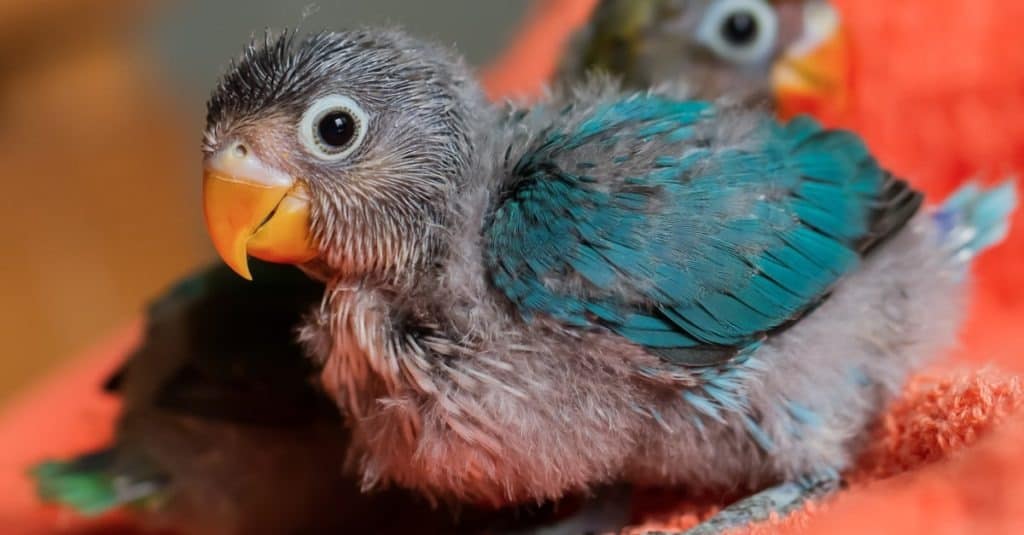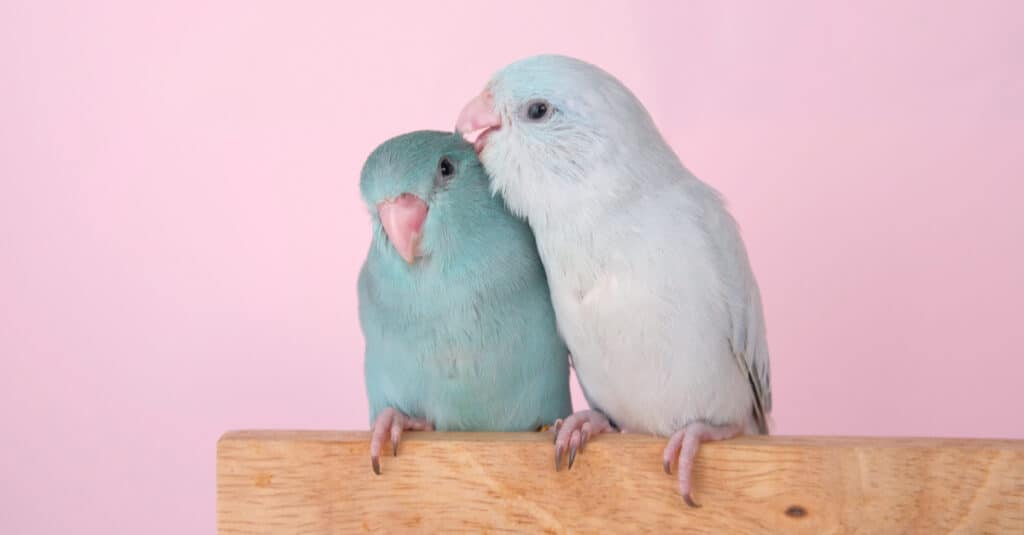Parrots have endeared themselves to humans worldwide with their intelligence, vibrant personalities, and ability to mimic speech. Almost 400 species of parrots (Psittacines) exist around the world, all belonging to the order Psittaciformes. Scientists divide these species into three families: true parrots (Psittacoidea), cockatoos (Cacatuoidea), and New Zealand parrots (Strigopoidea). Regardless of the species, there are some things all baby parrots have in common, from the adorable to the frustrating. Read on to discover fascinating facts about baby parrots!
1. Baby Parrots Have a Number of Different Names

There are different terms that describe specific stages in a young parrot’s life.
©Shark_749/Shutterstock.com
What do you call a baby parrot? The most common term is “chick,” an appellation that applies to many other species of birds, from chickens to hummingbirds. However, there are other terms that describe specific stages in a young parrot’s life. “Hatchling,” for example, applies to newly hatched baby parrots. At this stage of life, they are featherless, and their eyes are still closed.
Hatchlings become “nestlings” as they move out of the newborn stage. At this point, they still cannot leave the nest. This makes them entirely dependent upon their mother (and, in most parrot species, their father) for nutrition.
When a nestling develops enough to acquire its first set of feathers and leave the nest, it is a “fledgling” or “juvenile.” It ventures out of the nest onto nearby tree branches and begins the process of learning to fly. Its parents are still attentive during this phase.
2. Parrot Chicks Are Born Blind
Like many other species in the animal kingdom, baby parrots are born blind. Their eyes remain shut for approximately two weeks after birth, after which they open. This period of blindness results in total dependence upon the parents for survival. Birds born with closed eyes, limited down on their bodies, and total dependence on their parents are “altricial,” like parrots. Species born more fully developed are “precocial.”
3. Baby Parrots Don’t Have Adult Feathers

Parrot chicks are born without adult feathers.
©Bryoni Castelijn/Shutterstock.com
It may come as a surprise that parrot chicks are born without adult feathers. They lack the stunning plumage of their mature parents; instead, a patchy layer of down covers their otherwise naked bodies. Down is a soft underlayer of tiny, fine feathers designed to keep birds warm, especially waterfowl. In adult birds, it occurs under the outer layer of feathers.
Parrot chicks do not begin to grow this outer feathery layer until several weeks of age. In smaller species, feathers develop by four to six weeks of age. In larger species, feathers may not appear until the parrot is 10-15 weeks old.
Pin feathers are the first sign of mature plumage. This type of feather is a short shaft resembling a pin, which grows out of the parrot’s skin. This will also appear during its life as it molts (sheds old feathers) and grows new ones. Pin feathers are not typically painful for the parrot, though owners should be careful when handling them.
4. Baby Parrots Eat Regurgitated Food
As disgusting as it might sound, baby parrots eat their parents’ regurgitated food. Parrot chicks are unable to hunt down their own food until they reach the fledgling stage, and so rely on their parents to provide nutrition. Adult parrots regurgitate food from their crop, which is a muscular pouch for storing food. This pouch lies at the front of the neck above the sternum.
Parrots initiate regurgitation by bobbing their heads and clicking or gagging. Chicks open their mouths wide in a gesture known as “gaping” to indicate their readiness to receive food. This food may include insects, fruit, nuts, and seeds. Most parrot species also produce “crop milk” or “bird’s milk,” which is a whitish or yellowish liquid with a high concentration of fat and protein.
5. Baby Parrots Imprint on Their Parents

Imprinting allows bonds to form between humans and their pet parrots.
©CHUCHAT TREEPRAPHAKORN/Shutterstock.com
One of the first things a parrot chick does is seek out its parents. The first creature it sees upon opening its eyes is typically the one it accepts as its progenitor. This is the process of “imprinting” or accepting a given individual as one’s parents. This means that if a human cares for a chick from a very young age, it will assume the human is its proper caregiver.
Imprinting allows bonds to form between humans and their pet parrots. Without this process, it would be much more difficult to develop these bonds, as birds are naturally wary of human contact.
6. Adolescent Parrots Can Be Moody
Parrot chicks may look adorable, especially after they begin to get their first feathers, but they soon move beyond this into adolescence. At this stage of life, they face the same fluctuating hormones and moodiness as human teenagers. A pet parrot may suddenly become uncooperative and temperamental, with bouts of temper manifesting as aggression.
As frustrating as it may be, this is normal behavior in a juvenile parrot. Parrots are extremely intelligent with complex personalities, which means they are subject to common stressors. Moodiness and aggression may continue into the first few mating cycles until the parrot begins to gain some maturity.
7. Baby Parrots Mimic Sounds
Even at a young age, parrots are relentless mimickers. One study found that baby parrots “babble” much like human children do. They begin, of course, by mimicking the sounds their parents or other adult birds make. Later in their development, owners may be able to teach some species to speak human words. For small parrots, this may occur as early as three to six months; for larger species, it usually occurs between six and 12 months.
8. Baby Parrots Are Social Animals

Baby parrots have a strong need for socialization.
©John99/Shutterstock.com
Baby parrots have a strong need for socialization. From the beginning, their first priority is identifying their parents. They spend their first few weeks or months in the close company of their fellow nestmates under the constant supervision of their parents. In the wild, most parrot species live in flocks that provide support to monogamous pairs of parents and their young.
In captivity, it is vital to socialize parrot chicks and juveniles to prevent the development of temperamental disorders. Owners become an irreplaceable part of pet parrots’ social lives and may become their closest companions.
Parrots are highly intelligent birds with a strong need for socialization and stimulation. If handled properly and given the right care, they can become beloved lifelong companions.
Up Next:
- 10 Incredible Parrot Facts
- Parrot Lifespan: How Long Do Parrots Live?
- The 10 Most Beautiful Parrots in the World
The photo featured at the top of this post is © CHUCHAT TREEPRAPHAKORN/Shutterstock.com
Thank you for reading! Have some feedback for us? Contact the AZ Animals editorial team.






